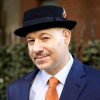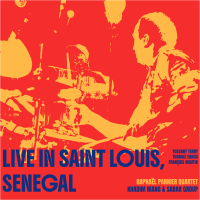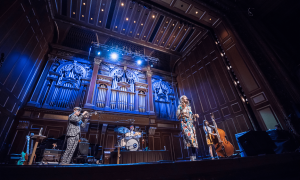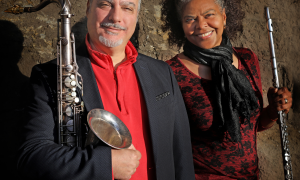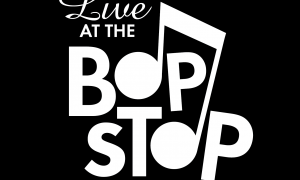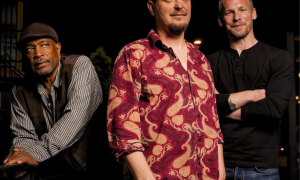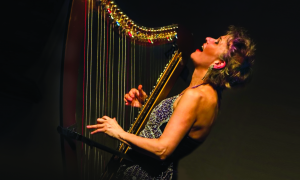Brian Charette knows his way around an organ. He began playing a Hammond M3 in high school but didn't graduate to the B3 until he moved to New York at age 20. While gigging in the city, he was schooled by Brother Jack McDuff in Harlem at Showman's Jazz Club.
Brian also knows how to write soul-jazz. His new album, Jackpot, is terrific. It features Brian on organ backed by Cory Weeds on tenor saxophone, Ed Cherry on guitar and Bill Stewart on drums. The album of Brian's originals was recorded for Cory's record label, Cellar Live. There's so much flavor in Brian's hands and feet, Cory is warm and centered player, Ed is as smooth as can be and Bill drives it all along with polyrhythmic figures.
Here's a short video about Brian...
And here's Highball...
Recently, I had a chance to find out more about Brian during an e-interview:
JazzWax: What was childhood like?
Brian Charette: I grew up in Meridian, Ct., on a retired dairy farm surrounded by rolling hills. My parents were and still are amazing. They exposed me to all sorts of interesting intellectual pursuits. When I was a kid, I was in a gifted program at Talcott Mountain Science Center in Avon, where I studied aeronautics. We built rockets and other things that fly. We had to calculate wind and trajectory. I also worked in a full musical instrument digital interface (MIDI) studio in 1984 on an early Macintosh computer. At home, I was a voracious reader and read books on physics and philosophy, as well as the Bible. My parents were schoolteachers, and my father wrote books on sacred geometry—which ascribes symbolic and sacred meanings to geometric shapes, such as the pyramids. As you can see, when I focus on something, it gets heavy fast.
JW: Did you travel?
BC: We did. My parents took us on cross-country trips to see historical sites, including Sun Studio in Memphis, the Grand Canyon, the Petrified Forest and the Grand Ole Opry in Nashville. My brother, Marc, is two years younger and plays the drums. By the time I was 15, I had been to every state in the continental U.S. But socially, I was introverted.
JW: Why?
BC: I had hearing problems at a young age. When I was 7 and 9, I had two procedures on my ears. My ear canals were blocked with skin and fluid. They put tubes in my ears to open the canals. Because of my hearing problems, I couldn't hear people unless I looked at them. I could hear a little and was already playing piano, but this slight handicap made me keep to myself. There were other issues. I was very heavy and not very child-like in my thinking, so other kids kind of stayed away from me and thought I was strange. I also had pretty complicated allergies and nasal issues. Recuperation from the procedure wasn’t too bad, but I was rather sickly, which is in contrast to now when I’m rarely sick. Oh, and a pinky finger was set wrong by a doctor after I broke it. I was inward focused.
JW: Anyone musical at home?
BC: My mother. I'd listen as she played classical piano. At age 5 or 6, I started to sit at the piano. She soon gave me lessons and I started formal training at 7 with a local piano teacher who was very good and rather strict, which made me a competent player fast.
JW: When did you start playing jazz?
BC: In junior in high school. A saxophonist in a rock band I was playing with introduced me to Charlie Parker. In high school, I tarted to play gigs locally with major jazz players such as Houston Person and Lou Donaldson. I soon bought a Hammond M3 to play in my rock band. The M3 is much smaller than the B3.
JW: Did you study jazz?
BC: Yes, at the Berklee College of Music in Boston for three weeks over the summer before college at the University of Connecticut. At Berklee, I was in Rick Peckham's John Scofield Ensemble, where I learned a lot about playing with a group and had my first jazz jams. They had lots of cool concerts at Berklee so I got to listen to lots of cool music. Berklee also had tape machines that played at 1/2 speed, which in 1990 was pretty uncommon. So I started to transcribe music for the first time. At the slower speed, I could hear each note more clearly, making it easier to transcribe solos on albums.
JW: A good jazz program at University of Connecticut?
BC: Very. The jazz band there was under the direction of Ellen Rowe. She brought in leading jazz artists such as Marvin Stamm, Kenny Wheeler and Joey Calderazzo. I also studied classical piano and form and analysis while playing lots of gigs. It was a time of great learning for me
JW: After college, who was most important to your organ development?
BC: I moved to New York in 1994 and lived with a friend in an apartment in the East Village. It’s the building on the cover of Led Zeppelin’s Physical Graffiti album. Back then, I was playing piano but soon bought a portable Hammond XB-2. For some reason, I immediately started to play lots of gigs on organ. Each Thursday night, I’d play in Harlem at Showman’s with Joey Morant, Jerry Weldon and Grady Tate. Then I met Jack McDuff in the dressing room at the Blue Note. He taught me to really play on his organ. [
JW: Who were you listening to?
BC: Jimmy Smith and Steve Winwood, Jon Lord and Chester Thompson. I loved the progressive rock records because of the sound made by the synthesizers and organ. I also was into Melvin Rhyne because of his amazing bebop lines. And Larry Young. Then I went back in time to organists like Ethel Smith and Milt Buckner
JW: How did you wind up playing behind so many celebrated artists after college, including Michael McDonald and Joni Mitchell?
BC: I was lucky to know great musical directors. I played organ behind Michael McDonald through my relationship with musicians Jimmy and Jerry Vivino. They put the band together. I also played a Central Park concert in 1999 celebrating the music of Joni Mitchell called Joni’s Jazz. In addition to Joni, performers included Joe Jackson and Chaka Khan. The band was organized by Vernon Reid. To bring myself up to speed, I transcribed the music on their playlists or we had sheet music.
JW: Tell me about your new album, Jackpot. What was your vision?
BC: I wrote all the songs in a hotel room in Budapest while on tour. I set up my keyboard in the room with headphones. Melodies and chords came to me as I was writing. I wanted memorable bebop melody lines and wanted to write them quickly so they weren't too complicated. I recorded at Rudy Van Gelder’s studio in New Jersey with Cory Weeds, Ed Cherry and Bill Stewart. I wrote the music with this band in mind. I wanted to have an album of grits-and-gravy swinging tunes just because I'd never really done that and I thought it was time.
Brian also knows how to write soul-jazz. His new album, Jackpot, is terrific. It features Brian on organ backed by Cory Weeds on tenor saxophone, Ed Cherry on guitar and Bill Stewart on drums. The album of Brian's originals was recorded for Cory's record label, Cellar Live. There's so much flavor in Brian's hands and feet, Cory is warm and centered player, Ed is as smooth as can be and Bill drives it all along with polyrhythmic figures.
Here's a short video about Brian...
And here's Highball...
Recently, I had a chance to find out more about Brian during an e-interview:
JazzWax: What was childhood like?
Brian Charette: I grew up in Meridian, Ct., on a retired dairy farm surrounded by rolling hills. My parents were and still are amazing. They exposed me to all sorts of interesting intellectual pursuits. When I was a kid, I was in a gifted program at Talcott Mountain Science Center in Avon, where I studied aeronautics. We built rockets and other things that fly. We had to calculate wind and trajectory. I also worked in a full musical instrument digital interface (MIDI) studio in 1984 on an early Macintosh computer. At home, I was a voracious reader and read books on physics and philosophy, as well as the Bible. My parents were schoolteachers, and my father wrote books on sacred geometry—which ascribes symbolic and sacred meanings to geometric shapes, such as the pyramids. As you can see, when I focus on something, it gets heavy fast.
JW: Did you travel?
BC: We did. My parents took us on cross-country trips to see historical sites, including Sun Studio in Memphis, the Grand Canyon, the Petrified Forest and the Grand Ole Opry in Nashville. My brother, Marc, is two years younger and plays the drums. By the time I was 15, I had been to every state in the continental U.S. But socially, I was introverted.
JW: Why?
BC: I had hearing problems at a young age. When I was 7 and 9, I had two procedures on my ears. My ear canals were blocked with skin and fluid. They put tubes in my ears to open the canals. Because of my hearing problems, I couldn't hear people unless I looked at them. I could hear a little and was already playing piano, but this slight handicap made me keep to myself. There were other issues. I was very heavy and not very child-like in my thinking, so other kids kind of stayed away from me and thought I was strange. I also had pretty complicated allergies and nasal issues. Recuperation from the procedure wasn’t too bad, but I was rather sickly, which is in contrast to now when I’m rarely sick. Oh, and a pinky finger was set wrong by a doctor after I broke it. I was inward focused.
JW: Anyone musical at home?
BC: My mother. I'd listen as she played classical piano. At age 5 or 6, I started to sit at the piano. She soon gave me lessons and I started formal training at 7 with a local piano teacher who was very good and rather strict, which made me a competent player fast.
JW: When did you start playing jazz?
BC: In junior in high school. A saxophonist in a rock band I was playing with introduced me to Charlie Parker. In high school, I tarted to play gigs locally with major jazz players such as Houston Person and Lou Donaldson. I soon bought a Hammond M3 to play in my rock band. The M3 is much smaller than the B3.
JW: Did you study jazz?
BC: Yes, at the Berklee College of Music in Boston for three weeks over the summer before college at the University of Connecticut. At Berklee, I was in Rick Peckham's John Scofield Ensemble, where I learned a lot about playing with a group and had my first jazz jams. They had lots of cool concerts at Berklee so I got to listen to lots of cool music. Berklee also had tape machines that played at 1/2 speed, which in 1990 was pretty uncommon. So I started to transcribe music for the first time. At the slower speed, I could hear each note more clearly, making it easier to transcribe solos on albums.
JW: A good jazz program at University of Connecticut?
BC: Very. The jazz band there was under the direction of Ellen Rowe. She brought in leading jazz artists such as Marvin Stamm, Kenny Wheeler and Joey Calderazzo. I also studied classical piano and form and analysis while playing lots of gigs. It was a time of great learning for me
JW: After college, who was most important to your organ development?
BC: I moved to New York in 1994 and lived with a friend in an apartment in the East Village. It’s the building on the cover of Led Zeppelin’s Physical Graffiti album. Back then, I was playing piano but soon bought a portable Hammond XB-2. For some reason, I immediately started to play lots of gigs on organ. Each Thursday night, I’d play in Harlem at Showman’s with Joey Morant, Jerry Weldon and Grady Tate. Then I met Jack McDuff in the dressing room at the Blue Note. He taught me to really play on his organ. [
JW: Who were you listening to?
BC: Jimmy Smith and Steve Winwood, Jon Lord and Chester Thompson. I loved the progressive rock records because of the sound made by the synthesizers and organ. I also was into Melvin Rhyne because of his amazing bebop lines. And Larry Young. Then I went back in time to organists like Ethel Smith and Milt Buckner
JW: How did you wind up playing behind so many celebrated artists after college, including Michael McDonald and Joni Mitchell?
BC: I was lucky to know great musical directors. I played organ behind Michael McDonald through my relationship with musicians Jimmy and Jerry Vivino. They put the band together. I also played a Central Park concert in 1999 celebrating the music of Joni Mitchell called Joni’s Jazz. In addition to Joni, performers included Joe Jackson and Chaka Khan. The band was organized by Vernon Reid. To bring myself up to speed, I transcribed the music on their playlists or we had sheet music.
JW: Tell me about your new album, Jackpot. What was your vision?
BC: I wrote all the songs in a hotel room in Budapest while on tour. I set up my keyboard in the room with headphones. Melodies and chords came to me as I was writing. I wanted memorable bebop melody lines and wanted to write them quickly so they weren't too complicated. I recorded at Rudy Van Gelder’s studio in New Jersey with Cory Weeds, Ed Cherry and Bill Stewart. I wrote the music with this band in mind. I wanted to have an album of grits-and-gravy swinging tunes just because I'd never really done that and I thought it was time.
This story appears courtesy of JazzWax by Marc Myers.
Copyright © 2026. All rights reserved.



